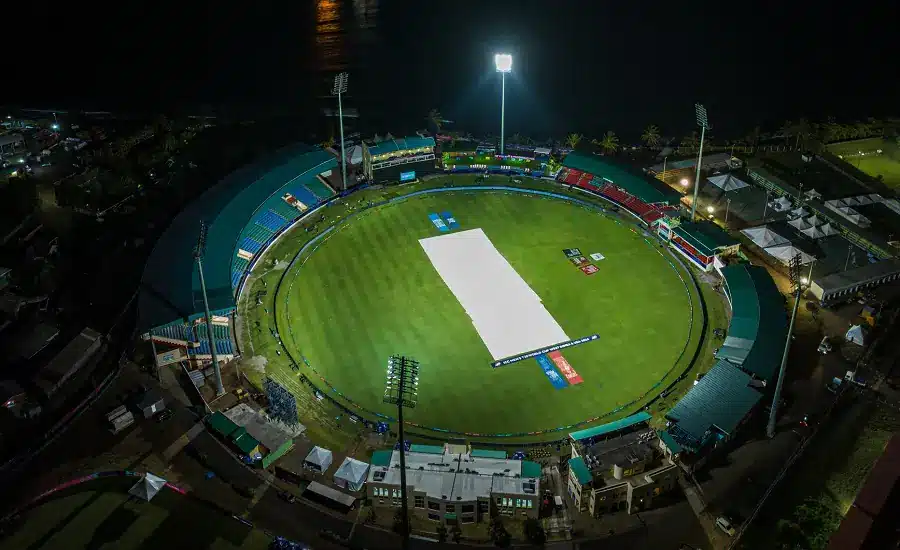The International Cricket Council (ICC), world cricket’s governing body, has rated the pitches prepared at the Arnos Vale Sports Complex for the T20 Men’s World Cup as “satisfactory” in its ratings, released Tuesday, on the pitches used for the prestigious, highest level competition.
The ICC T20 Men’s World Cup, held in June, was co-hosted by he USA and the Caribbean. In the Caribbean leg, St Vincent and the Grenadines hosted five matches, all of which were played at the country’s premier sporting facility, Arnos Vale Sports Compelex on which the government spent close to $40 million to upgrade, including resurfaced pitches and outfield, lights and an electronic scoreboard.
It was St Vincent and the Grenadines’ first time ever hosting World Cup events.
The Arnos Vale Sports Complex received “satisfactory” ratings for all five matches played: June 13th – Bangladesh v The Netherlands; June 14th – South Africa v Nepal; June 16th – Bangladesh v Nepal; June 22nd – Afghanistan v Australia; and June 24th – Afghanistan v Bangladesh.
The ICC also rated as “very good” the outfield on all matches.
Of the 52 pitches used for the tournament, the cricket governing body deemed three pitches, two in the USA and one in the West Indies, to be ‘unsatisfactory’. And, 31 pitches were rated ‘satisfactory’ and 18 playing strips received a rating of ‘very good’ in the ICC’s ratings. Two matches were abandoned during the tournament while one ended with no result.
The Nassau County Cricket Stadium in New York which hosted eight matches in the group stage, received two ‘unsatisfactory’ ratings for the Sri Lanka vs South Africa and India vs Ireland contests – the first two matches held at the ground, and the Brian Lara Academy in Tarouba, which hosted the semi-final between Afghanistan and South Africa, was also rated as “unsatisfactory.”
During the matches in New York, Sri Lanka was skittled out for 77 against South Africa on June 3, and Ireland was bowled out for 96 by India two days later.
In the second game, several players from both teams experienced rough blows due to the uneven bounce. Rohit Sharma had to leave the field as a precaution after being struck on the upper arm by Josh Little.
Rishabh Pant also suffered a blow to the body from Little, while Ireland’s Harry Tector was struck on the finger by a short ball from Jasprit Bumrah.
At the time, Andy Flower expressed concern that the New York pitch was “bordering on dangerous”, while former England captain Michael Vaughan labeled it as “shocking”.
The modular venue in New York was constructed in just five months. The ICC brought in Damian Hough, the chief curator at the Adelaide Oval, to prepare the drop-in pitches.
However, following criticism from various sources, the ICC admitted that the pitches were below standard, and the short turnaround time between matches (New York hosted eight games in two weeks) did not aid the situation.
Before the upcoming game between Canada and Ireland, maintenance work was conducted to cover areas on the field where grass shoots were growing through the cracks.
The field surface was leveled out by adding topsoil and rolling it in. The grounds in New York, where India played against Pakistan, resulting in 119 runs beating 113 for 7, were evaluated as “satisfactory”.
The field surface for the semi-final match, where Afghanistan was bowled out for 56, drew significant attention. Some deliveries stayed low, while others unexpectedly rose from the same spot. Afghanistan’s head coach, Jonathan Trott, was clear that the pitch was not suitable for a semi-final match.
Speaking after the match, Trott said: “That’s not the pitch that you want to have a match, a semi-final of a World Cup, on plain and simple. It should be a fair contest.
“I’m not saying it should be flat completely with no spin and no seam movement, but I’m saying you shouldn’t have batsmen worrying about going forward and the ball flying over their head. You should be confident in your foot movement and being able to hit through the line or use your skills.”
In general, the playing surfaces at the Brian Lara Cricket Academy were quite challenging. During a match, West Indies struggled at 30 for 5 before eventually defending their total of 149 against New Zealand.
The surface at Providence for India vs. England semi-final was rated as “satisfactory,” whereas the Kensington Oval pitch for the final between India and South Africa was rated as “very good”.
The ICC expressed overall satisfaction with the conditions of the outfields, with only New York and Guyana receiving “satisfactory” ratings, while the rest were rated as “very good.”




